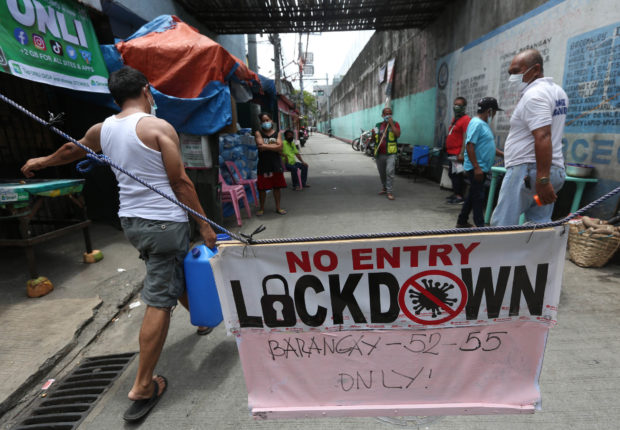Gov’t opts for granular lockdowns as NCR COVID cases only come from few barangays

PRECAUTION Barriers have been set up in several villages in Pasay City to prohibit nonresidents from going in and out of these communities as Metro Manila undergoes granular lockdown to contain the spread of COVID-19. INQUIRER file photo / MARIANNE BERMUDEZ
MANILA, Philippines — The government’s new strategy of piloting granular lockdowns in Metro Manila is based on data showing 80 percent of COVID-19 cases detected in the region were only found in 11 percent to 30 percent of its barangays, a Department of Health (DOH) official explained Tuesday.
“Ito pong policy shift na pinaguusapan natin, it came from the analysis of our data showing that whenever we put these areas under lockdown, pag tinignan natin, yung 80 percent ng mga bagong kaso natin ay actually hindi naman po sa lahat ng barangay ng buong siyudad or buong munisipyo,” DOH epidemiology bureau director Alethea de Guzman said during a Palace briefing.
(The policy shift we’re talking about, came from the analysis of our data showing that whenever we put these areas under lockdown, if we look at it, 80 percent of the new cases don’t come from all barangays of a city or a municipality.)
“Base po sa data natin sa NCR, naglalaro lamang from 11 to 30 percent of barangays are actually contributing to the 80 percent of our cases,” she added.
(Based on our NCR data, only around 11 to 30 percent of barangays are contributing to the 80 percent of our cases.)
Article continues after this advertisementDe Guzman added that the imposition of wide-scale quarantine measures like the enhanced community quarantine (ECQ) or the MECQ is only to “buy time” to improve the country’s public health and critical care capacities.
Article continues after this advertisementShe also stressed the “core strategies” of reducing COVID-19 cases like adherence to minimum health standards, shortening the interval from case detection to isolation to under five days, and increasing the COVID-19 vaccination coverage.
“Our projections done by our partner FASSSTER showed that even at lower community quarantine levels, if we improve these three strategies, halos yung epekto niya po ay parang nag-ECQ,” De Guzman said.
(Our projections done by our partner FASSSTER showed that even at lower community quarantine levels if we improve these three strategies, its effect is almost like ECQ.)
“This is our way to balance health and economy. We want to reduce cases and safely open our sectors so our people can continue working,” she added.
Metro Manila will be under general community quarantine for the rest of the month of September. During this period, the region will also pilot the use of granular lockdowns where restrictions will only be imposed in small areas.